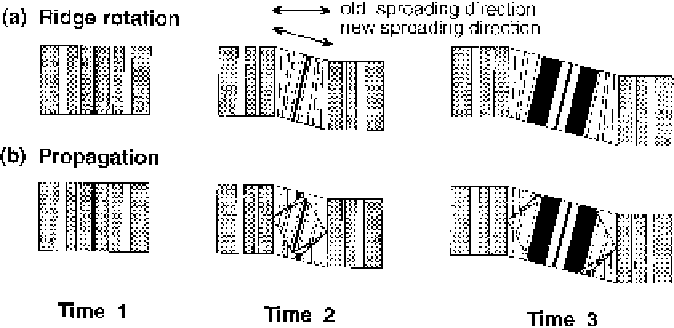Geoscience Reference
In-Depth Information
Figure 3.23.
Magnetic-anomaly patterns for two possible mechanisms by which a
mid-ocean ridge could adjust to changes in its spreading direction caused by a
change in rotation pole. (a) Ridge rotation. In this model the spreading at the ridge is
asymmetrical during the adjustment time. Half-spreading rates are not equal on
both sides of the ridge and vary along the length of the ridge. (b) Propagating rifting.
In this model a section of the ridge is assumed to jump to its new orientation. This
'propagating' ridge segment then lengthens and pseudofaults develop at oblique
angles to the ridge as observed in Fig. 3.22(a). (From Wilson
et al
.(1984).)
was spreading. All that remains are short segments of the ridge and fragments
of the Farallon plate, now the Juan de Fuca, Explorer, Gorda, Cocos and Nazca
plates.
The change in direction of the magnetic anomalies in the Great Magnetic Bight
region indicates that a third plate was involved (Fig. 2.16 shows that three ridges
meeting at a triple junction would produce such an anomaly pattern). This third
plate has been named the Kula plate. The Pacific, Farallon and Kula plates are
thus assumed to have met at an RRR triple junction (the Kula Triple Junction).
The spreading rates and directions of these ridges have to be determined from
the anomalies and fracture zones in the vicinity of the Great Magnetic Bight. The
Kula plate has been subducted beneath the North American plate and so no
longer exists, athough a very small piece may be trapped on the Pacific plate
in the western Aleutian arc. Both the other ridges have also been subducted.
Putting all of this information together to determine the motions of the plates in
the northern Pacific region for the last 80 Ma involves much spherical geometry
and computing. An idealized flat-plate model illustrating the main features of
the evolution of the northeastern Pacific was shown in Chapter 2, Problem 2.
Figure 3.25 shows a reconstruction of the evolution of this region from 50 Ma
until the present time. From 80 Ma until about 55 Ma there were four plates in
this northern Pacific region (North America, Kula, Farallon and Pacific). Two of
them were being subducted beneath the North American plate: the Kula plate
in the north and the Farallon plate farther south. About 55 Ma ago the northern

